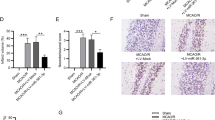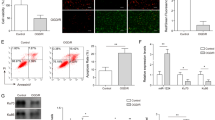Abstract
This study aimed to explore the mechanism of miR-320 in regulating biological characteristics of ischemic cerebral neuron by mediating Nox2/ROS pathway. Primary neurons were cultured and grouped: normal group (normal primary neurons), negative control (NC) group (ischemic primary neurons, transfected with negative control plasmid), model group (ischemic primary neurons), miR-320 mimic group (ischemic primary neurons, transfected with miR-320-overexpressed plasmid), Nox2 vector group (ischemic primary neurons, transfected with Nox2-overexpressed plasmid), and miR-320 mimic + Nox2 vector group (ischemic primary neurons, co-transfected with miR-320- and Nox2-overexpressed plasmid). Dual-luciferase reporter assay showed that there was the target relationship between miR-320 and Nox2. miR-320 expression was significantly decreased, and Nox2 expression was significantly increased in the rest groups compared with normal group (both P < 0.05). There was a co-localization of miR-320 and Nox2 in the cytoplasm. Cell proliferation, contents of superoxide dismutase (SOD), catalase (CAT), and glutathione peroxidase (GSH-PX), and mRNA and protein expressions of Ki67, Bcl-2, and c-myc were significantly declined, and apoptosis rate, contents of malondialdehyde (MDA) and reactive oxygen species (ROS), and caspase-3 mRNA and protein expressions were significantly increased in the rest groups compared with normal group (all P < 0.05). miR-320 promoted cell proliferation; increased contents of SOD, CAT, and GSH-PX; and declined apoptosis and contents of MDA and ROS. Moreover, miR-320 could affect the regulation of Nox2/ROS pathway on ischemic cerebral neuron by negatively regulating Nox2 expression. Overexpressed miR-320 affects the proliferation, apoptosis, and oxidative stress injury of ischemic cerebral neuron by inhibiting Nox2/ROS pathway.







Similar content being viewed by others
References
Almasi M, Firoozabadi NH, Ghasemi F, Chardoli M (2016) The value of ABCD2F scoring system (ABCD2 combined with atrial fibrillation) to predict 90-day recurrent brain stroke. Neurol Res Int 2016:1–5
Bisio I, Estatico C, Fedeli A, Lavagetto F, Pastorino M, Randazzo A, Sciarrone A (2018) Brain stroke microwave imaging by means of a Newton-conjugate-gradient method in Lp Banach spaces. IEEE Trans Microw Theory Tech 66:1–15
Cho RL, Yang CC, Lee IT, Lin CC, Chi PL, Hsiao LD, Yang CM (2016) Lipopolysaccharide induces ICAM-1 expression via a c-Src/NADPH oxidase/ROS-dependent NF-κB pathway in human pulmonary alveolar epithelial cells. Am J Physiol Lung Cell Mol Physiol 310:L639–L657
Gheinani AH, Burkhard FC, Monastyrskaya K (2013) Deciphering microRNA code in pain and inflammation: lessons from bladder pain syndrome. Cell Mol Life Sci 70:3773–3789
Guo Y, Han B, Luo K, Ren Z, Cai L, Sun L (2017) Nox2-ROS-HIF-1α signaling is critical for the inhibitory effect of oleanolic acid on rectal cancer cell proliferation. Biomed Pharmacother 85:733–739
Hamzei Taj S, Kho W, Riou A, Wiedermann D, Hoehn M (2016) MiRNA-124 induces neuroprotection and functional improvement after focal cerebral ischemia. Biomaterials 91:151–165
Huang J, Meng Y, Liu Y, Chen Y, Yang H, Chen D, Shi J, Guo Y (2016) MicroRNA-320a regulates the osteogenic differentiation of human bone marrow-derived mesenchymal stem cells by targeting HOXA10. Cell Physiol Biochem Int J Exp Cell Physiol Biochem Pharmacol 38:40–48
Jung YS, Lee SW, Park JH, Seo HB, Choi BT, Shin HK (2016) Electroacupuncture preconditioning reduces ROS generation with NOX4 down-regulation and ameliorates blood-brain barrier disruption after ischemic stroke. J Biomed Sci 23:32
Kim SM, Hur DY, Hong SW, Kim JH (2017a) EBV-encoded EBNA1 regulates cell viability by modulating miR34a-Nox2-ROS signaling in gastric cancer cells. Biochem Biophys Res Commun 494:550–555
Kim YM, Kim SJ, Tatsunami R, Yamamura H, Fukai T, Ushio-Fukai M (2017b) ROS-induced ROS release orchestrated by Nox4, Nox2 and mitochondria in VEGF signaling and angiogenesis. Am J Physiol Cell Physiol 312:C749–C764
Lou Z, Wang AP, Duan XM, Hu GH, Zuo ML, Yang ZB (2018) Role of ALK5/SMAD2/3 signaling in the regulation of NOX expression in cerebral ischemia/reperfusion injury. Exp Ther Med 16:1671–1678
Meng F, Zhang Z, Chen W, Huang G, He A, Hou C, Long Y, Yang Z, Zhang Z, Liao W (2016) MicroRNA-320 regulates matrix metalloproteinase-13 expression in chondrogenesis and interleukin-1β-induced chondrocyte responses. Osteoarthr Cartilage 24:932–941
Mokhtari T, Akbari M, Malek F, Kashani IR, Rastegar T, Noorbakhsh F, Ghazi-Khansari M, Attari F, Hassanzadeh G (2017) Improvement of memory and learning by intracerebroventricular microinjection of T3 in rat model of ischemic brain stroke mediated by upregulation of BDNF and GDNF in CA1 hippocampal region. Daru J Pharm Sci 25:4
Qi ZL, Liu YH, Qi SM, Ling LF, Feng ZY, Li Q (2016) Salidroside protects PC12 cells from H2O2-induced apoptosis via suppressing Nox2-ROS-MAPKs signaling pathway. J South Med Univ 37:178–183
Shi C, Zhang Z (2017) MicroRNA-320 suppresses cervical cancer cell viability, migration and invasion via directly targeting FOXM1. Oncol Lett 14:3809–3816
Song YC, Li WJ, Li LZ (2015) Regulatory effect of miRNA 320a on expression of aquaporin 4 in brain tissue of epileptic rats. Asian Pac J Trop Med 8:807–812
Sudharani K, Sarma TC, Prasad KS (2016) Brain stroke detection using K-nearest neighbor and minimum mean distance technique. International Conference on Control
Tournier PH, Bonazzoli M, Dolean V, Rapetti F, Hecht F, Nataf F, Aliferis L, El-Kanfoud I, Migliaccio C, de Buhan M, Darbas M, Semenov S, Pichot C (2016) Numerical modeling and high-speed parallel computing: new perspectives on tomographic microwave imaging for brain stroke detection and monitoring. IEEE Antennas & Propagation Magazine PP:1-1
Vishnubalaji R, Hamam R, Yue S, Al-Obeed O, Kassem M, Liu FF, Aldahmash A, Alajez NM (2016) MicroRNA-320 suppresses colorectal cancer by targeting SOX4, FOXM1, and FOXQ1. Oncotarget 7:35789–35802
Wang J, Shi C, Wang J, Cao L, Zhong L, Wang D (2017) MicroRNA-320a is downregulated in non-small cell lung cancer and suppresses tumor cell growth and invasion by directly targeting insulin-like growth factor 1 receptor. Oncol Lett 13:3247–3252
Wang X, Chen S, Ni J, Cheng J, Jia J, Zhen X (2018) MiRNA-3473b contributes to neuroinflammation following cerebral ischemia. Cell Death Dis 9:11
Wu Y, Zhu M, Li D, Zhang Y, Wang Y (2016) Brain stroke localization by using microwave-based signal classification. International Conference on Electromagnetics in Advanced Applications
Xu C, Wang X, Gu C, Zhang H, Zhang R, Dong X, Liu C, Hu X, Ji X, Huang S, Chen L (2017a) Celastrol ameliorates Cd-induced neuronal apoptosis by targeting Nox2-derived ROS-dependent PP5-JNK signaling pathway. J Neurochem 141:48–62
Xu X, Zhang L, Ye X, Hao Q, Zhang T, Cui G, Yu M (2017b) Nrf2/ARE pathway inhibits ROS-induced NLRP3 inflammasome activation in BV2 cells after cerebral ischemia reperfusion. Inflamm Res 67:57–65
Yang J, Qi J, Xiu B, Yang B, Niu C, Yang H (2019) Reactive oxygen species play a biphasic role in brain ischemia. J Investig Surg 32:97–102
Yin Q, Lu H, Bai Y, Tian A, Yang Q, Wu J, Yang C, Fan TP, Zhang Y, Zheng X, Zheng X, Li Z (2016) A metabolite of Danshen formulae attenuates cardiac fibrosis induced by isoprenaline, via a Nox2/ROS/p38 pathway. Br J Pharmacol 172:5573–5585
Zeng LL, He XS, Liu JR, Zheng CB, Wang YT, Yang GY (2016) Lentivirus-mediated overexpression of microRNA-210 improves long-term outcomes after focal cerebral ischemia in mice. CNS Neurosci Ther 22:961–969
Zhang Y, Wang T, Yang K, Xu J, Wu JM, Liu WL (2016) NADPH oxidase 2 does not contribute to early reperfusion-associated reactive oxygen species generation following transient focal cerebral ischemia. Neural Regen Res 11:1773–1778
Zhang C, Wang J, Ma X, Wang W, Zhao B, Chen Y, Chen C, Bihl JC (2018) ACE2-EPC-EXs protect ageing ECs against hypoxia/reoxygenation-induced injury through the miR-18a/Nox2/ROS pathway. J Cell Mol Med 22:1873–1882
Ziaee SM, Tabeshmehr P, Haider KH, Farrokhi M, Shariat A, Amiri A, Hosseini SM (2017) Optimization of time for neural stem cells transplantation for brain stroke in rats. Stem Cell Investig 4:29
Funding
This work was supported by the Nature Science Foundation Project of Ningbo (No. 2018A610306).
Author information
Authors and Affiliations
Corresponding author
Ethics declarations
Conflict of Interest
The authors declare that they have no conflict of interest.
Additional information
Publisher’s Note
Springer Nature remains neutral with regard to jurisdictional claims in published maps and institutional affiliations.
Rights and permissions
About this article
Cite this article
Shen, W., Lu, Y., Hu, J. et al. Mechanism of miR-320 in Regulating Biological Characteristics of Ischemic Cerebral Neuron by Mediating Nox2/ROS Pathway. J Mol Neurosci 70, 449–457 (2020). https://doi.org/10.1007/s12031-019-01434-5
Received:
Accepted:
Published:
Issue Date:
DOI: https://doi.org/10.1007/s12031-019-01434-5




